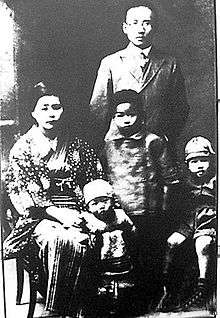Tomiko Satō
| Tomiko Sato | |
|---|---|
 Guo Muoruo and Sato Tomiko with their children | |
| Born |
佐藤をとみ (Otomi Sato)[1][2] 1894 |
| Died | 1995 (aged 100–101) |
| Other names | Anna Guo |
| Spouse(s) | Guo Moruo |
| Children |
Guo Hefu (1917–1994) Guo Bo (b. 1920) Guo Fusheng Guo Shuyu Guo Zhihong |
Tomiko Satō (佐藤 富子 Satō Tomiko, 1894-1995) was the common-law wife of the Chinese Communist scholar and poet Guo Moruo. She is often referred to in Chinese sources as Guo Anna (Chinese: 郭安娜), the way Guo Moruo called her.[3] Satō Tomiko spent about 20 years with Guo, in Japan and in China, until they were separated by the war, and they had five children together.[3]
Biography
Tomiko Satō was the eldest of eight children in the family of a Japanese Protestant minister in the Ohira village, Kurokawa District, Miyagi Prefecture (north-eastern Honshū). In her teens she studied at a Baptist boarding school in Sendai, the capital of the prefecture. At 21, rebelling against the prospect of an arranged marriage, she left her home prefecture and went to Tokyo, where she found a job with St Luke's Hospital as a student nurse.[3]
Satō's relationship with Guo Moruo started in the summer of 1916, about a year after her arrival to Tokyo. A friend of Guo, named Chen Longji (陈龙骥),[4] happened to be treated for tuberculosis at St Luke's Hospital. Guo, who had just completed his first year of study in Japan, visited his sick friend in the hospital on his trip to Tokyo, but the patient died soon. After the death of his friend, Guo met her when visiting the hospital to request the dead friend's X-ray records. Satō was sharing Guo's grief over the death of his friend, and once Guo returned to Okayama, they started regularly exchange letters. By December, Guo Moruo convinced Satō to leave Tokyo and join him in Okayama.[5]
Satō and Guo had their first child, a son, in December 1917.[5]
Satō and Guo's union was vehemently opposed by both of their families, and ill-received by the community they were in.
In April 1923, Satō moved with Guo and their three children to Shanghai. They had financial difficulties, and in February 1924 she went to Japan, taking the children along, but returned to Shanghai in mid-November.[5]
After the Marco Polo Bridge Incident in July 1937, the war between China and Japan started for real. On July 25, Guo managed to escape Japan and to return to his homeland. As his attempts to get her and their children out of Japan later that year were frustrated by the Japanese government, Satō was left alone to take care of the children in wartime Japan. She resisted the pressure of the authorities to have them naturalized as Japanese citizens; this protected them from the prospect of being conscripted and possibly sent to fight against their father's country. The four elder children were able to enter Kyoto Imperial University; all graduated, and became specialists in industrial chemistry, aquaculture, architecture, and mathematics.[3]
When interviewed in 1980 by Sawachi Hisae (澤地久枝), who was to write her biography,[6] Satō summarized her life story as follows: "I am a stray dog all my life, but whatever bitterness can be said about this bitter life, that was because of my own foolishness". She died in 1995, aged 101.
Published works
- Sato, Tomiko (1938). 我的丈夫郭沫若 (Waga masurao kaku matsujaku) [My husband Mo Ruo]. Shanghai: Nisshinsha. ASIN B000JAJY8U. OCLC 674273223. [7]
- 佐藤富子 (Sato, Tomiko) (2016). Translated by Chinese: 赵艺真. "回到中国的郭沫若" [Memories of Mo Ruo in China]. 郭沫若学刊 [Journal of Go-Moruo Studies] (in Chinese) (2): 33–38. ISSN 1003-7225.
References
- ↑ "Ichikawa no bunkajin > Kaku Matsujaku purofīru [Guo Muoruo, profile - Citizen of Ichikawa]" (in Japanese). Ichikawa City Museum of Literature. August 14, 2012. Retrieved August 20, 2018.
- ↑ Sawachi 1983, p. 120.
- 1 2 3 4 Yan Lu. Re-understanding Japan: Chinese Perspectives, 1895–1945. University of Hawaii Press, 2004. ISBN 0-8248-2730-9 Partial text on Google Books
- ↑ 楚丘 (Chu Qiu), 郭沫若的“女神”们 Archived 2012-08-03 at Archive.is (Guo Moruo's "Goddesses") (in Chinese)
- 1 2 3 Chen Xiaoming, From the May Fourth Movement to Communist Revolution. SUNY Press, 2007. ISBN 0-7914-7137-3. Partial text on Google Books Pages 16–17
- ↑ Sawachi, Hisae (1983). Zoku Shōwashi no onna [Women in the Shōwa History: the sequel]. Tokyo: Bungeishunjū. ISBN 4-16-723907-8. OCLC 566318767.
- ↑ e-book available. 佐藤富子 (1938). 我的丈夫郭沫若 [Wo de zhang fu guo mo ruo] [My husband Mo Ruo]. Zhan shi wen hua cong shu cong shu wai ji. Zuodeng Fuzi zhu. Hankou: 戰時文化出版社 [Zhan shi wen hua chu ban she]. OCLC 759098729.